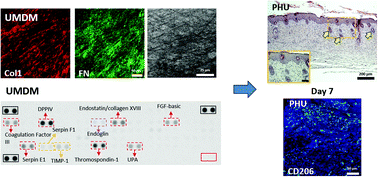Extracellular matrices derived from different cell sources and their effect on macrophage behavior and wound healing†
Abstract
A decellularized extracellular matrix (dECM) is an excellent biomaterial in regenerative medicine, due to its biomimetic nature in targeting tissues and organs. In this study, we prepared cell-derived ECMs (CDM) derived from four different cell sources, characterized them individually, and found that intrinsic properties of each CDM were substantially different in terms of the fibrous matrix, total protein, and biochemical factors. Based on such information, we selected two ECM candidates, the human lung fibroblast derived matrix (hFDM) and the umbilical cord-blood mesenchymal stem cell derived matrix (UMDM) for the study of ECM-macrophage interactions in vitro and in vivo. In fact, UMDM was the richer in both total protein and angiogenic-related cytokines than any other CDM. When THP-1 cell-derived macrophages (M0) were seeded onto the UMDM or the hFDM, it showed a mixed cell morphology of macrophage phenotype and the macrophages (M0) preconditioned on UMDM presented more diverse cytokine release profiles. The treatment of conditioned medium obtained from CDM-seeded macrophages showed that UMDM could yield significantly advanced wound closure in 24 h via the human dermal fibroblast scratch model. To investigate the role of ECM on macrophage polarization in vivo, we prepared an ECM hydrogel, a mixture of each CDM and Pluronic F127/hyaluronan, and applied them onto a full-thickness mouse skin wound model for 2 weeks. The therapeutic efficacy as assessed via histology and immunofluorescence staining (α-SMA and CD206) revealed that the UMDM-treated group showed more effective wound healing compared to the other groups, as proven via the thinner epidermal layer, significant recovery of skin appendage, better neovascularization, and higher recruitment of myofibroblasts and larger number of macrophages (M2) at 7 days. The difference between UMDM and hFDM was marginal. Taken together, among the CDMs, UMDM and hFDM are promising resources of ECM, showing a great potential for wound healing. Although the mechanism is not fully understood, bioactive innate factors in UMDM may contribute individually and/or collectively to advance wound healing.



 Please wait while we load your content...
Please wait while we load your content...